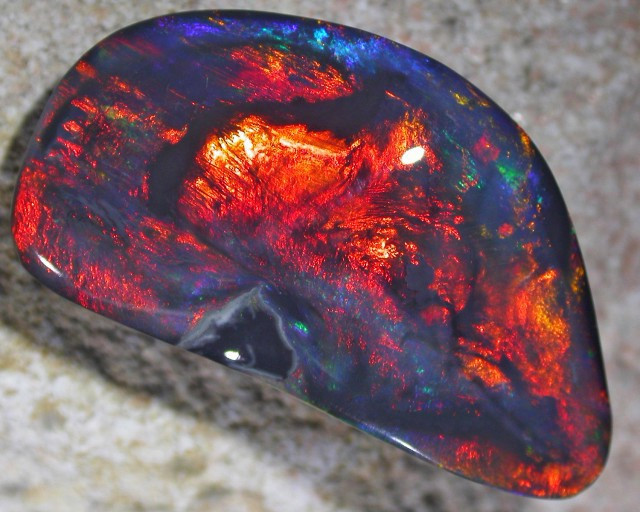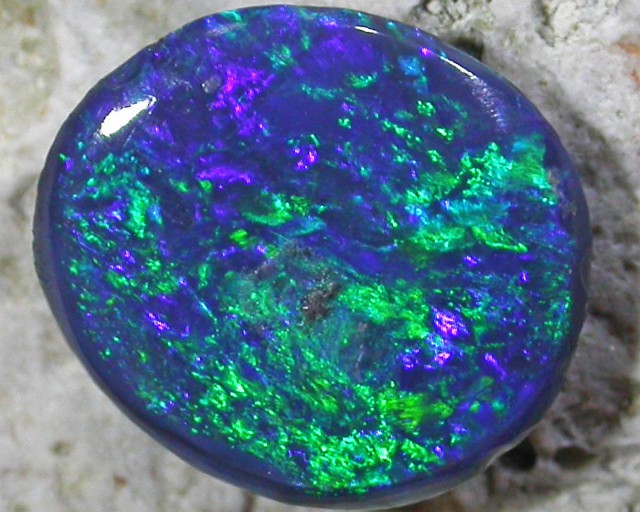
Objavljeno 5th Sep 2019
Izmijenjeno 17th Nov 2025
Koje je boje opal?
 Ako volite opale, vjerojatno je vaš mjesec rođenja listopad. Ili ste razvili ljubav prema jedinstvenom i šarenom sjaju opala.
Ako volite opale, vjerojatno je vaš mjesec rođenja listopad. Ili ste razvili ljubav prema jedinstvenom i šarenom sjaju opala.
Što opale čini tako posebnima? Pa, samo jedan kamen opal može obuhvatiti spektar boja, a sve sjaje u privlačnom, opalescentnom sjaju koji je potpuno jedinstven za opale.
Možda se pitate zašto su opali toliko šareni i koje su točno boje. Postoji nekoliko čimbenika koji doprinose jedinstvenoj dugi boja koju opal emitira. Međutim, da bismo u potpunosti objasnili ovo prirodno čudo, prvo moramo definirati neke znanstvene pojmove.
Ne brinite, nećemo biti previše tehnički detaljni, ali uključit ćemo tek toliko informacija da vam pomognemo u potpunosti shvatiti koji procesi uzrokuju takvu šarenu raznolikost opala.
Što je opal?
Opal je amorfan ili bezobličan kamen sastavljen od silicija. Struktura unutar opala sadrži sitne organizirane sfere, svaka poredana u dosljednom i organiziranom rasporedu. Kada svjetlost izravno prolazi kroz te sfere i dođe u kontakt sa silicijem, svjetlost se lomi i emitira razne boje.
Opali su rodni kamen listopada i označavaju nadu, čistoću i sreću. Ovo prekrasno kamenje poznato je po svojoj "igri boja", jer se može brzo mijenjati iz svijetlih, užarenih boja u intenzivne i jarke vatrene boje.
Po definiciji, riječ "opal" znači vidjeti promjenu boje. U nastavku ćemo opisati znanost i terminologiju koja objašnjava zašto opal toliko mijenja boju. 
Što je difrakcija?
Kada se svjetlost razbije u niz traka, one mogu emitirati svijetle, tamne ili obojene trake. Kod opala, difrakcija stvara širok spektar živih boja, od blijedosive do intenzivne plave i vatreno crvene.
Što je defleksija?
Kada svjetlost prolazi kroz objekt i savija se, mijenja smjer iz ravne ili izravne linije. Otklon utječe na spektar vidljive svjetlosti, omogućujući našim očima da vide složeni niz opalescentnih boja koje zrače iz opala.
Što je opalescencija?
Malo kamenja ima poseban izraz kojim opisuje svoj jedinstveni izgled. Dio onoga što opale čini tako posebnima je njihova opalescencija. Ukratko, opalescencija se odnosi na optički efekt dobiven jedinstvenim rasporedom značajki koje opal ima: sjaj, boja, sjaj, blistavost i iridescencija. Izrazi opalescencija i iridescencija koriste se naizmjenično, međutim prvi se izravno pripisuje opalu.
Kako otklon i difrakcija utječu na boju opala
Veličina sfera unutar strukture opala utjecat će na to koje su boje vidljive nama. Svjetlost koja prolazi kroz opal prvo se skreće ili savija, zatim se difraktira ili lomi, a na kraju se boje emitiraju iz svjetlosnih zraka u kamenu. Razlog zašto opal izgleda prelijevajući se i višebojan je taj što kada se kamen pomiče, svjetlost će udariti u različite sfere pod različitim kutovima unutar kamena, zračeći raznim jedinstvenim bojama. Na taj način, opali se čine kao da stalno mijenjaju i mijenjaju svoju boju.
Zbog ovog faktora, nazvati opal samo jednom bojom nije nužno lako jer sadrži više boja. Bez obzira na to kako nagnete ili pomaknete opal, on će svaki put odražavati različite boje. Zato su opali tako atraktivni komadi nakita. Dok se jednobojno kamenje može dobro slagati s raznim bojama, opali izvlače boje iz svakog prostora u dugi, što ih čini izvrsnim komadom nakita. 
Drugi čimbenici koji utječu na boju opala
Kao što različiti kutovi pod kojima držite opal otkrivaju različite boje, tako će i veličina kamena diktirati boju. Zato je tako teško definirati opal kao jednu boju. Međutim, postoje neka praktična pravila.
- Veliki opali okruglog i ovalnog oblika otkrit će tople crvene tonove.
- Mali opali bit će hladni, emitirajući pretežno plave i zelene tonove.
- Kamenje intenzivno obojeno ukazuje na to da je struktura silicija unutar kamena ujednačena.
Vrste opala
Kao što ste do sada shvatili, odrediti jednu boju koja bi opisala širok raspon boja unutar opala težak je zadatak. Međutim, postoje uobičajene kategorije opala. Evo pogleda na neke od popularnih i jedinstvenih dostupnih opala:
- Bijeli opali imaju bijelu, mliječno nijansu osnovne boje, a istovremeno emitiraju prekrasan pastelni spektar boja.
- Crni opali imaju tamnu bazu i pretežno odražavaju plave, zelene i sive tonove.
- Vatreni opali sadrže iskre intenzivnih vatrenih boja, uključujući crvenu, narančastu i žutu.
- Kristalni opali su gotovo prozirni i odražavaju svijetle i jasno definirane boje.
- Plavi opali variraju od svijetlosive do akvamarin i tirkizne do tamnoplave boje, te imaju pruge pješčanih, narančastih i mliječno obojenih zemljanih tonova.
- Ružičasti opali su breskvaste, losos boje i prošarani crnom i tamno narančastom bojom.
- Kristalni opali su kristalni opali grube formacije sa svijetlim, neonskim bojama.
- Trobojni opali su izuzetno rijetki i pretežno su srebrne ili ružičaste boje s mekim, satenskim završetkom. Boja ovih jedinstvenih opala oponaša izgled smrznutog leda.
Kako se opali koriste u nakitu?
Sirovi opali čine jedinstvene ukrase koji su savršeni za nakit. Opali se mogu koristiti kao prekrasne ogrlice, privjesci za prstenje, ukrasno kamenje, ogrlice i naušnice. Predivno je to što opali dolaze u raznim oblicima i bojama, što znači da možete prilagoditi svoj nakit i imati širok raspon stilova za odabir. 
Opali se često režu u jedinstvene oblike, uključujući srca, trokute, pravokutnike, pa čak i oblike životinja poput dupina i kornjača. Zlatari će čak spajati opale s drugim kamenjem poput lapis lazulija i labradorita kako bi stvorili jedinstven, šareni komad.
Bilo da se nose kao odgovarajući set naušnica, jedinstveni privjesak s dragim kamenjem ili svjetlucavi prsten, opali su jedan od najeklektičnijih i najjedinstvenijih darova prirode. Ako želite sažeti živopisni spektar duge u jednom kamenu, opali su savršen izbor.
KUPUJTE OPALE
Pretražite Opal Encyclopedia
Povezane aukcije
povezani članci
Opali koji su izgledali napuknuto možda su samo napukli. Raspravit ćemo o razlici između njih dvoje i objasniti kako se napukli opal može popraviti.
8th May 2018
Pogledajte naš vodič o tome kako odabrati nakit s opalom. S toliko različitih kamenja koje možete odabrati, to može biti jedna od najtežih stvari.
17th Oct 2018
Najnoviji članci
Crni opali su najtraženija vrsta opala, s dubokim bazama koje daju dugu odsjaja na vrhu. Otkrijte upotrebu, svojstva, povijest i vrijednost crnih opala!
7th Dec 2025
Otkrijte kako se opali ocjenjuju i koji čimbenici utječu na njihovu cijenu. Od boje i svjetline do brušenja i podrijetla, saznajte kako se svaka vrsta opala procjenjuje - s primjerima cjenovnih raspona.
19th Jul 2023
Krenite na putovanje i saznajte više o ljekovitoj moći opala od naše gostujuće spisateljice Vivien Schapere iz Crystal Healing Techniques!
20th May 2023
Kategorije članaka
All there is to know about Opals including Black Opals, Ethiopian Opals & Boulder Opal
14 Članci
Check out our fascinating information and articles on all things amazing in the Opal world
41 Članci
Opal Auctions sellers who are approved as opal Verified Sellers
4 Članci








